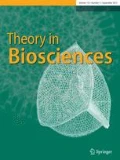Abstract
Understanding how biological systems solve problems could aid the design of novel computational methods. Information processing in unicellular eukaryotes is of particular interest, as these organisms have survived for more than a billion years using a simple system. The large amoeboid plasmodium of Physarum is able to solve a maze and to connect multiple food locations via a smart network. This study examined how Physarum amoebae compute these solutions. The mechanism involves the adaptation of the tubular body, which appears to be similar to a network, based on cell dynamics. Our model describes how the network of tubes expands and contracts depending on the flux of protoplasmic streaming, and reproduces experimental observations of the behavior of the organism. The proposed algorithm based on Physarum is simple and powerful.



Similar content being viewed by others
Abbreviations
- FS:
-
Food source
- FT:
-
Fault tolerance
- SMT:
-
Steiner minimum tree
- TL:
-
Total length of the tube network
References
Dorigo M, Stützle T (2004) Ant colony optimization. MIT Press, Cambridge
Kamiya N (1959) Protoplasmic streaming. Protoplasmatologia 8. Springer, Lewis Victor Heilbrunn
Kessler D (1982) Plasmodial structure and motility. In: Aldrich HC, Daniel JW (eds) Cell biology of Physarum and Didymium. Academic Press, New York, pp 145–196
Miyaji T, Onishi I (2007) Mathematical analysis to an adaptive network of the plasmodium system. Hokkaido Mathematical Journal 36:445–465
Miyaji T, Onishi I (2008) Physarum can solve the shortest path decision problem mathematically rigorously. Int J Pure Appl Math (in press)
Nakagaki T, Yamada H, Tóth A (2000) Maze-solving by an amoeboid organism. Nature 407:470
Nakagaki T, Yamada H, Ueda T (2000) Interaction between cell shape and contraction pattern. Biophys Chem 84:195–204
Nakagaki T (2001) Smart behavior of true slime mold in labyrinth. Res Microbiol 152:767–770
Nakagaki T, Yamada H, Tóth A (2001) Path finding by tube morphogenesis in an amoeboid organism. Biophys Chem 92:47–52
Nakagaki T, Yamada H, Hara M (2004) Smart network solutions in an amoeboid organism. Biophys Chem 107:1–5
Nakagaki T, Kobayashi R, Nishiura Y, Ueda T (2004) Obtaining multiple separate food sources: behavioural intelligence in the Physarum plasmodium. Proc R Soc Lond B 271:2305–2310
Nakagaki T, Saigusa T, Tero A, Kobayashi R (2007) Effects of amount of food on path selection in the transport network of an amoeboid organism. In: Proceedings of the international symposium on topological aspects of critical systems and networks. World Scientific, Singapore, pp 94–100
Nakagaki T, Guy R (2008) Intelligent behaviors based on complex dynamics of soft matter in the Physarum plasmodium. Soft Matter 4:57–67
Tero A, Kobayashi R, Nakagaki T (2006) Physarum solver a biologically inspired method for road-network navigation. Physica A363:115–119
Tero A, Kobayashi R, Nakagaki T (2007) Mathematical model for adaptive transport network in path finding by true slime mold. J Theor Biol 244:553–564
Acknowledgments
This research was supported by Grants-in-aid for Scientific Research (nos. 18650054, 18654022 and 19340023) from the Japan Society for the Promotion of Science and by a Research Grant from the Human Frontier Science Program (no. RGP51/2007).
Author information
Authors and Affiliations
Corresponding author
Rights and permissions
About this article
Cite this article
Tero, A., Yumiki, K., Kobayashi, R. et al. Flow-network adaptation in Physarum amoebae. Theory Biosci. 127, 89–94 (2008). https://doi.org/10.1007/s12064-008-0037-9
Received:
Accepted:
Published:
Issue Date:
DOI: https://doi.org/10.1007/s12064-008-0037-9




